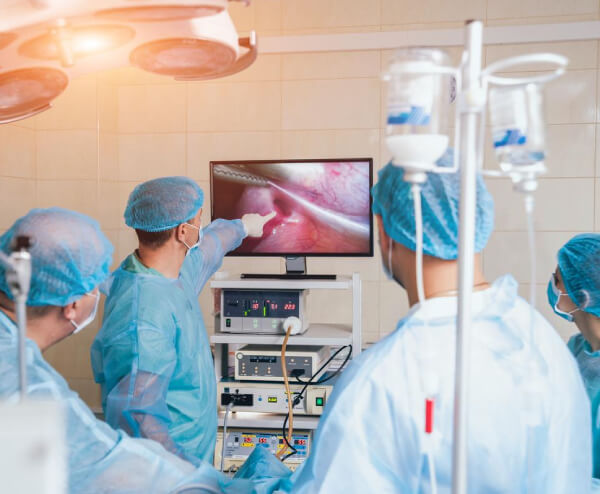
Laparoscopy Procedure for Fertility Treatment
Laparoscopy, a minimally invasive surgical procedure, utilizes a small instrument known as a “laparoscope” equipped with a light source and camera. The laparoscope is inserted into the abdomen through a tiny incision. By doing so, the surgeon gains visual access to the internal pelvic, abdominal, and uterine organs, including the fallopian tubes and ovaries. This enables them to diagnose and treat various conditions related to infertility and other issues.
What is laparoscopy for infertility?
Tubal and peritoneal factors contribute to approximately 30-40% of female infertility cases, often requiring surgical intervention. Within this category, obstructions, adhesions, or fibroids in the fallopian tubes, as well as conditions such as endometriosis, tubal malformations, and congenital malformations, account for about 30-40% of cases.
There are two primary types of laparoscopic surgery:
- Diagnostic laparoscopy: This procedure aims to visualize and diagnose infertility-related issues. It allows the surgeon to directly observe the pelvic and abdominal organs to identify any abnormalities or factors contributing to infertility.
- Operative (therapeutic) laparoscopy: This type of laparoscopy involves surgical intervention to address specific concerns. It is used to remove adhesions (abnormal tissue connections) or abnormal growths that may be hindering fertility or causing other complications.
By utilizing laparoscopic techniques, medical professionals can both diagnose and treat a range of infertility-related issues, helping to improve the chances of successful conception.
When is laparoscopy performed?
Laparoscopy serves as both a diagnostic tool and a surgical procedure for various disorders affecting the abdomen or pelvis. It allows for the identification of specific conditions and enables surgical interventions such as organ removal or tissue sampling for biopsy.
The following are common indications for laparoscopy:
- Palpable abdominal lump: If there is a noticeable lump in the middle of the abdomen, laparoscopy can be employed to investigate and diagnose the underlying cause.
- Treatment of abdominal cancer: Laparoscopic surgery can be used to remove certain types of abdominal cancers, providing a less invasive alternative to traditional open surgery.
- Persistent or severe abdominal pain: Laparoscopy is frequently utilized to diagnose and address the underlying causes of persistent or severe abdominal pain, offering a direct visualization of the abdominal organs.
- Heavy menstrual periods in women: Laparoscopy may be recommended for women experiencing abnormally heavy menstrual periods to identify and address any contributing factors.
- Surgical options for contraception: For women considering surgical methods of birth control, laparoscopy can be performed to facilitate procedures such as tubal ligation or placement of intrauterine devices (IUDs).
- Evaluation of fertility issues: In cases where a woman is experiencing difficulty getting pregnant, laparoscopy can be used to assess potential fertility issues and investigate any abnormalities that may be impacting conception.
Laparoscopy serves as a versatile tool, offering diagnostic capabilities and surgical interventions for a range of conditions affecting the abdomen and pelvis.
What medical issues prevent you from getting a laparoscopy?
There are specific circumstances in which diagnostic or therapeutic laparoscopy may not be feasible or advisable. These conditions include:
- Pregnancy beyond 16 weeks: Laparoscopy is generally avoided during pregnancy, particularly after the 16-week mark, to minimize potential risks to the developing fetus.
- Cardiopulmonary disease: Individuals with severe heart or lung conditions may not be suitable candidates for laparoscopy due to the potential strain it can place on the cardiovascular and respiratory systems.
- Severe pelvic infections: Active and severe pelvic infections can increase the risk of complications during laparoscopy. In such cases, the procedure may need to be postponed until the infection is adequately treated.
- Generalized peritonitis: Generalized peritonitis, which is widespread inflammation of the abdominal lining, may necessitate an alternative approach rather than laparoscopy due to the extent of the condition.
- Intestinal obstruction: In cases of intestinal obstruction, where the normal flow of intestinal contents is blocked, laparoscopy may not be feasible, and other treatment modalities may be required.
- Advanced stages of cancer: Laparoscopy may not be appropriate for individuals with advanced stages of cancer, particularly when the cancer has spread extensively throughout the pelvic region.
- Anticoagulation treatment: Laparoscopy may be contraindicated for individuals receiving anticoagulation treatment, as it can increase the risk of bleeding and other complications.
Procedure of laparoscopy
During a laparoscopy, the surgeon typically creates a small incision, measuring approximately 1 to 1.5 cm (0.4 to 0.6 inches), near your belly button.
To provide a clearer view of the organs and more operating space, carbon dioxide gas is then pumped into the abdomen through this incision. This inflation of the abdomen allows the surgeon to visualize the area better. The laparoscope, a slender tube with a camera, is inserted through this incision. The laparoscope transmits images to a television monitor in the operating room, enabling the surgeon to have a clear view of the entire area.
If the laparoscopy involves surgical intervention, such as an appendix removal, additional small incisions may be made in the abdomen. Through these incisions, small surgical instruments are inserted, guided by the laparoscope to the appropriate location. Once in position, the instruments are used by the surgeon to perform the necessary treatment or surgery.
After the procedure, the incisions are closed with stitches or clips, a bandage is applied, and the carbon dioxide gas in the abdomen is released.
Diagnostic laparoscopy typically takes around 30 to 60 minutes to complete. However, the duration may be longer if the surgeon is performing a specific surgical procedure, depending on the complexity of the surgery involved.
Laparoscopic treatment has many benefits
- Cost-effectiveness: Laparoscopy is a cost-efficient option compared to traditional open surgery, as it typically involves shorter hospital stays and fewer resources.
- Reduced pain: The use of smaller incisions in laparoscopy results in less post-operative pain and discomfort compared to larger incisions used in open surgery.
- Quicker recovery: Laparoscopy generally allows for a faster recovery time, enabling patients to return to their regular activities sooner.
- Early hospital discharge: Due to the minimally invasive nature of laparoscopy, patients often experience shorter hospital stays and can be discharged earlier.
- Lower risk of infection: Laparoscopic procedures carry a lower risk of infection compared to open surgery, primarily due to the smaller incisions and reduced exposure of internal organs to external contaminants.
- Minimal scarring: The use of small incisions in laparoscopy results in minimal scarring, with only small scars visible after the procedure.
What is the risk associated with laparoscopy?
Laparoscopy, like any surgical procedure, carries certain risks, which may include:
- Infection: There is a possibility of developing an infection at the incision sites or within the abdominal cavity.
- Injury to internal organs: While rare, there is a risk of unintentional injury to nearby structures such as the ureter, blood vessels, stomach, or colon during the procedure.
- Bleeding: In some cases, laparoscopy may result in bleeding that may require a blood transfusion or further intervention.
- Adverse effects of anesthesia: Anesthesia carries its own risks, including allergic reactions or complications related to the administration of anesthesia.
- Abdominal infection or inflammation: Laparoscopy can occasionally lead to infection or inflammation within the abdomen, known as peritonitis.
- Hernia: In rare instances, the development of a hernia at the incision sites may occur after laparoscopy.
- Blood clots: Although uncommon, there is a slight risk of developing blood clots, known as deep vein thrombosis (DVT), following laparoscopy.
It is important to note that these risks are typically low, and the majority of laparoscopic procedures are performed without complications. However, it is essential to discuss potential risks with your healthcare provider and address any concerns you may have before undergoing the procedure.
Why Choose Us?
We Receive the Best Patient’s Review.

Adeola Ogunjimi

Jessica Wong

Babatunde Okeke

Damilola Ajayi

Funmilayo Akinwande
Blogs on Infertility, IVF, IUI and More
Valuable advice and informative articles on lifestyle, fertility, and infertility for both men and women.
Get a FREE Consultation From Our Fertility Experts Today!






